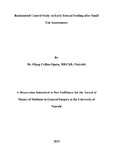| dc.contributor.author | Olang, Collins O | |
| dc.date.accessioned | 2014-01-21T07:59:05Z | |
| dc.date.available | 2014-01-21T07:59:05Z | |
| dc.date.issued | 2013 | |
| dc.identifier.citation | Master of Medicine in General Surgery | en_US |
| dc.identifier.uri | http://hdl.handle.net/11295/64058 | |
| dc.description.abstract | Studies show that early enteral feeding after small gut intestinal anastomosis has a better
outcome than delayed feeding.The outcome measures are short duration of hospital stay,
lower incidence of infection and anastomotic leak. Traditionally enteral feeding has been
delayed until the return of bowel sounds or passage of flatus.This practice is not grounded on
scientific facts as delayed feeding decreases the deposition of collagen at the anastomotic site,
causes mucosal atrophy and negative nitrogen balance .The practice of early enteral feeding
(EEF) if adopted will reduce the duration of hospital stay and reduce the overall healthcare
costs. Experience in Kenyatta National Hospital (KNH) shows that delayed feeding is
preferred after intestinal anastomosis.
Objective: This randomized control study sought to compare the outcome of early enteral
feeding versus delayed feeding after small gut anastomosis.
Main outcome measures: The length of hospital stay, infection rate and rate of anastomotic
leak.
Study design: Randomized control study.
Setting: Kenyatta National Hospital a tertiary hospital in Kenya.
Study duration: 1st of March to 30th September 2012.
Methods and materials: 66 patients were randomly selected and classified into two groups,
group A were fed with liquid diet 6hrs post-operative whereas patients in group B were fed
after return of bowel sounds or passage of flatus. The following outcome measures were
compared between the study and the control groups: anastomotic leak, wound infection and
duration of hospital stay.
Results: The mean length of hospital stay was shorter in the early feeding group (7·3 days,
95% CI 6·9-7·6 days) compared to the delayed feeding group (9·7 days CI 7·6-11·7 days).
This is statistically significant (p=0·02). The anastomotic leak rate was 3% in the delayed
feeding group and none in the study group (p=0·314).The wound infection rate was higher in
the delayed feeding arm (15%) than in the early feeding arm (6%) p=0·23. | en_US |
| dc.language.iso | en | en_US |
| dc.publisher | University of Nairobi | en_US |
| dc.title | Randomised control study on early enteral feeding after small gut anastomosis | en_US |
| dc.type | Thesis | en_US |
| dc.description.department | a
Department of Psychiatry, University of Nairobi, ; bDepartment of Mental Health, School of Medicine,
Moi University, Eldoret, Kenya | |

